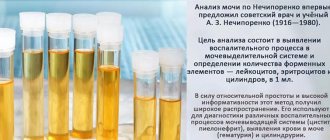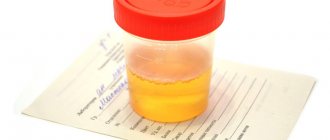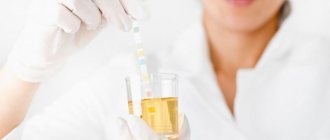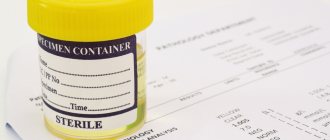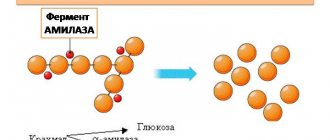Basic requirements for preparing a patient for urine analysis
1. The patient collects urine independently (with the exception of seriously ill patients). 2. It is necessary to carry out proper urine collection, observing the rules of hygiene as carefully as possible. 3. You should not collect urine during menstruation. After cystoscopy, a urine test can be prescribed no earlier than 5-7 days later. 4. Preliminary toileting of the external genitalia: in women, toileting of the external genitalia is carried out with a sterile cotton swab moistened with warm soapy water (treatment of the labia by moving the swab in front and downwards); dried with a clean cloth, previously ironed with a hot iron. in men - the external opening of the urethra is toileted with warm water and soap, then washed with warm water and dried with a clean napkin, previously ironed with a hot iron
• General urine analysis For general analysis, use the first morning portion of urine (the previous urination should be no later than 2 am). Toilet the external genitalia. For men, when urinating, completely pull back the skin fold and release the external opening of the urethra. For women, spread the labia. Pour the first few milliliters of urine into the toilet. Collect the entire portion of morning urine in a dry, clean container while urinating freely. Pour 40-50 milliliters of the total volume of urine into a special container and close the lid tightly. You cannot take urine from a vessel or potty. The collected urine should be immediately delivered to the laboratory. It is allowed to store urine in the refrigerator (at t +2? +4° C), but no more than 1.5 hours.
• Collecting daily urine Collect urine for 24 hours using normal drinking regimen (1.5-2 liters per day): At 6-8 o'clock in the morning, empty the bladder (pour out this portion of urine). Within 24 hours, collect urine in a clean container with a capacity of at least 2 liters. During collection, the container with urine must be stored in a cool place (optimally in the refrigerator on the bottom shelf at +4? +8 ° C), preventing it from freezing. Collect the last portion of urine at exactly the same time when collection began the day before. Measure the amount of urine and pour 50-100 ml into a clean container. Be sure to write on the container the volume of urine collected per day.
• Urinalysis according to Nechiporenko Collect urine in the morning (immediately after sleep) using the 3-glass sample method: start urinating in the toilet, collect the middle portion in a container for laboratory testing, and finish in the toilet. The second portion of urine should prevail in volume. Deliver a medium portion of urine to the laboratory in a special container. Report the time of urine collection to the registrar. It is allowed to store urine in the refrigerator (at t +2° +4°), but not more than 1.5 hours. FUNCTIONAL TESTS
• Urinalysis according to Zimnitsky Collect urine for 24 hours on a normal drinking regimen (1.5-2 liters per day), taking into account the amount of fluid drunk per day. At 6 o'clock in the morning, empty your bladder (pour out this portion of urine). Every 3 hours during the day, collect urine in separate containers, which indicate the time of collection and the portion number. 8 servings in total: 1 serving - from 6-00 to 9-00 am, 2 serving - from 9-00 to 12-00, 3 serving - from 12-00 to 15-00, 4 serving - from 15-00 to 18. -00, 5 portion - from 18-00 to 21-00, 6 portion - from 21-00 to 24-00, 7 portion - from 24-00 to 3-00, 8 portion - from 3-00 to 6-00 hours. Deliver the entire collected amount of urine in 8 containers to the laboratory. URINE COLLECTION FOR MICROBIOLOGICAL STUDIES
• Urine culture (with determination of sensitivity to antibiotics) Collect urine in a sterile container: THE FIRST 15 ml of URINE IS NOT USED FOR ANALYSIS! Collect the next 3-10 ml in a sterile container and screw the lid on tightly. Deliver the biomaterial to the laboratory within 1.5-2 hours after collection. It is allowed to store the biomaterial in the refrigerator at t +2 +4° C for no more than 3-4 hours. If delivered to the laboratory later than the specified time, the results of urine culture may be unreliable. Urine collection must be carried out before the start of drug treatment and no earlier than 5 days after the course of treatment.
Seal
Collection of urine for general analysis
Algorithm of actions
1. Prepare in advance a container with a lid for collecting urine: wash with a detergent, rinse at least 3 times to remove any residual detergent, dry thoroughly, stick a piece of paper on it with the patient’s name, department name and room number.
2. Teach the patient the technique of hygienic procedures and the rules for submitting urine for analysis: the patient should be explained that on the morning of the test it is necessary to wash the external genitalia and perineum with warm water and soap in a certain sequence (pubic area, external genitalia, perineum, anus) and wipe the skin dry in the same order.
3. Explain to the patient where he should leave the container with urine, closed with a lid.
4. In the morning after the hygienic procedure, the patient should release the initial portion of urine into the toilet on a count of “1-2”, and then hold urination and, replacing the jar, collect 150–200 ml of urine in it (the so-called average portion of the urine stream), if necessary after finishing urinating into the toilet.
5. For a menstruating patient, in cases where the examination cannot be postponed, it is recommended to close the vagina with a cotton swab.
6. In a seriously ill patient, collect urine with a catheter.
7. Deliver urine to the laboratory no later than an hour after its collection.
Features of urine collection using various research methods:
— Nechiporenko test : after the hygienic procedure, 5–10 ml from an average portion of urine is collected into a clean container;
- Amburger's test : the patient should urinate into the toilet at 5 a.m., then wash thoroughly, and at 8 a.m. urinate into a previously prepared container (volume 0.5 l);
— Kakovsky-Addis test : the patient should urinate in the toilet at 10 o’clock in the evening, try not to go to the toilet at night, and in the morning at 8 o’clock after the hygienic procedure, collect all the urine into a prepared container (volume 0.5–1 l);
— Zimnitsky's test
:
the patient must urinate in the toilet at 6 a.m., then sequentially collect urine in numbered containers, changing them every 3 hours;
if there is no urine within 3 hours, the container remains empty; all eight containers must be marked indicating the portion number and time of urine collection: No. 1 – 6.00–9.00; No. 2 – 9.00–12.00; No. 3 – 12.00–15.00; No. 4 – 15.00–18.00; No. 5 – 18.00–21.00; No. 6 – 21.00–24.00; No. 7 – 24.00–3.00; No. 8 – 3.00–6.00; - bacteriological examination
urine
: in the morning the patient should wash himself thoroughly, then collect 10–15 ml of urine from the middle portion into a sterile test tube and immediately close it with a stopper;
- collection of daily urine : in the morning at 8 a.m. the patient must urinate in the toilet, then collect urine in a graduated container or three-liter jar during the day until 8 a.m. the next day inclusive; if it is planned to analyze daily urine for glucose, protein, etc., after collecting urine, the nurse measures the total amount of urine and points it in the direction, then carefully stirs all the urine with a wooden stick and pours 100-150 ml of urine into a bottle for the laboratory;
- to determine diastase in urine, 50 ml of freshly excreted warm urine is examined in the laboratory.
Help with renal colic: administration of antispasmodic and analgesic drugs, differentiated use of heat taking into account age and somatic status: heating pads on the lumbar region or hot baths with a water temperature of 38–39 ºС for 10–20 minutes.
Reminder for collecting urine tests
Technique for collecting urine for general analysis
After toileting the external genitalia, morning urine is collected for general analysis in a disposable pharmaceutical container of at least 50 ml. In this case, the first portion of urine is released into the toilet, and the middle portion is collected in a container.
Technique for collecting urine analysis “according to Nechiporenko”
After toileting the external genitalia, an average portion of morning urine of at least 20 ml is collected. The first and last portions of urine are poured into the toilet into a disposable pharmaceutical container. Technique for collecting daily urine
Urine is collected over 24 hours. In the morning, before collecting urine, it is necessary to toilet the external genitalia. The first portion of urine in the morning is released into the toilet and the time of urination is noted. Next, all urine during the day (until the same time the next day) should be collected in one container (usually a 3-liter jar with a lid is used, which is stored in the refrigerator).
After collecting the material, you must independently assess the total volume of urine collected. After which the urine is mixed and part of it (at least 100 ml) is poured into a special container. It is this container that is delivered to the laboratory (the entire volume of urine does not need to be delivered). When submitting urine to the laboratory, it is necessary to indicate from what time to what time the urine was collected and what the total volume of urine was.
Technique for collecting urine for bacteriological culture
Prepare a sterile container for collecting urine. Wash your hands with soap, then thoroughly wash your external genitalia. After washing, take a sterile container to collect urine and open the lid so as not to touch the inner surface of the lid and container. Release the first stream of urine into the toilet, hold urination, place a container, release urine into the container in an amount of at least 10 - 15 ml, flush the remaining portion of urine into the toilet. Carefully close the lid of the container without touching the edges of the neck.
Hypothermia, overheating and spilling urine are not allowed!
Technique for collecting urine for glucosuric profile
Daily urine is collected in three clean separate jars, and the time of urine collection is signed on each jar.
- from 6:00 to 14:00;
- from 14:00 to 22:00;
- from 22:00 to 6:00.
The amount of urine collected is measured in milliliters.
Urine is poured from each jar into a separate plastic container (at least 50 ml), and the time of urine collection is signed on each container.
Urine collection technique for the Rehberg test
On the eve of the study, it is necessary to exclude physical activity, alcoholic drinks, strong tea, spicy and fatty foods.
Urine is collected over 24 hours. In the morning, before collecting urine, you need to toilet the external genitalia. The first portion of urine in the morning is released into the toilet and the time of urination is noted. Next, all urine during the day (until the same time the next day) should be collected in one container (usually a 3-liter jar with a lid is used, which is stored in the refrigerator). After collecting the material, you must independently assess the total volume of urine collected. After which the urine is mixed and part of it (at least 150 ml) is poured into a special container. It is this container that is delivered to the laboratory (the entire volume of urine does not need to be delivered). When submitting urine to the laboratory, it is necessary to indicate from what time to what time the urine was collected and the total volume of urine. Indicate your height, weight and amount of liquid drunk during the day. When delivering a urine test to the laboratory, you must donate blood on that day to determine your creatinine level (fasting).
Urine collection technique according to Zimnitsky
Urine collection for the Zimnitsky test is carried out at certain hours during the day. The test is carried out with normal drinking and nutrition.
In order to correctly collect the required material you need:
- 8 clean containers with a lid, each holding a volume of 200 ml, label each with the time of urine collection;
- a clock, preferably with an alarm clock (urine collection should occur at certain hours);
- a notepad for recording the liquid consumed during the day (including the volume of liquid received with soup, milk, etc.)
At 6 o'clock in the morning you need to empty your bladder into the toilet. Throughout the day, every 3 hours you need to empty your bladder into jars (if one container is not enough, take an additional container).
It is necessary to strictly observe a 3-hour gap between urine portions.
- from 6 to 9 am - collect all urine excreted over the next 3 hours into the first container;
- from 09 to 12 o'clock - to the second container;
- from 12 to 15 o'clock - on the third;
- from 15 to 18 hours - on the fourth;
- 18 to 21 o'clock - at five;
- from 21 to 24 o'clock - at six;
- from 24 to 03 o’clock – at seven o’clock;
- from 03 to 06 a.m. fill the last, eighth container.
Jars to be filled must be kept cool and closed (in the refrigerator). The next morning, you must take all the jars with their contents to the laboratory, additionally providing records of the liquid consumed during the day.
